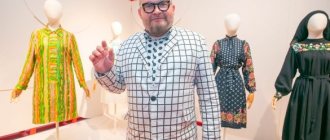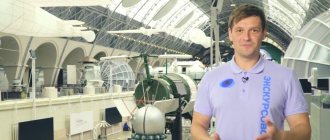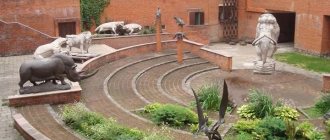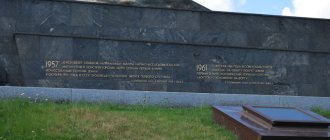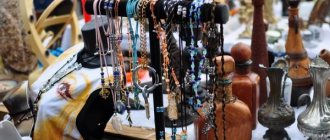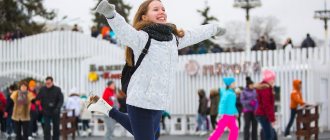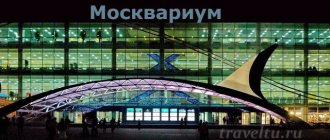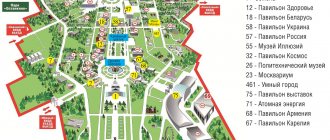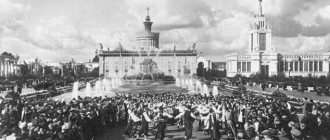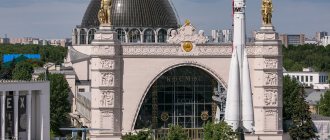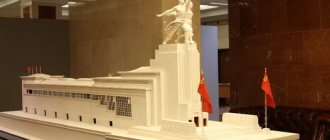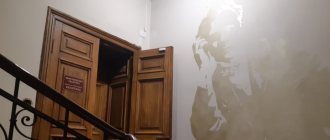History of creation
In the summer of 1936, according to the master plan of the All-Russian Agricultural Exhibition, construction of a wooden pavilion began according to the design of M.B.
Schneider for the exhibition “Grain”. Later, the project was partially reworked by the architectural workshop of the Exhibition under the leadership of V.K. Oltarzhevsky with the participation of M.A. Minkus and A.P. Ershov and implemented in 1937. And a year later, the content of the pavilion also changed, where the “Cotton” exhibition was transferred, which previously occupied the building on the site of the modern chapel of St. Basil the Great. The facade of the Cotton pavilion was designed in the Art Deco style. The paired columns forming the portico gave its architecture rhythmic rigor and peace.
In 1940, the entrance group was decorated with stucco, ornamental patterns and paintings, covering the entire surface of the wall in the depths of the portico. In this image, the pavilion perfectly coped with the role of a symbol of the success of Soviet cotton growing and the independence of the USSR from foreign supplies of “white gold”.
During the post-war reform of the All-Russian Agricultural Exhibition, a new exhibition was placed in the building - “Agriculture”. The change in profile required a different external appearance of the pavilion, which was also due to a significant change in the Mechanization area and an increase in the dimensions of many of the Exhibition buildings.
Architects P.P. worked on the reconstruction project for pavilion No. 26. Revyakin, A.I. Ignatieva, A.I. Gromov and V.P. Tukanov. They created a strict monumental portico-loggia of the introductory part, in contrast to the massive facade of the non-preserved Livestock Pavilion. The new head volume made it possible to equip the introductory and lecture halls, as well as the necessary office space, practically without affecting part of the pre-war building.
Exposition
The exhibition spaces of the Polytechnic University are divided between two venues - VDNKh and the Moscow technopolis.
VDNH
The exhibition has been closed since March 1, 2021 due to the imminent opening of the main museum building.
A temporary exhibition entitled “Russia Does Itself” tells the story of great Russian scientists of the past and present, legendary scientific discoveries and little-known developments of our time. A standard sightseeing tour of the exhibition includes: stories about the most unusual ideas for using nuclear energy; a fun story about electromagnetic waves and the “taming” of lightning; a story about famous discoveries that scientists were inspired by nature. You can order an individual excursion on a topic of interest from the fields of physics, biology and chemistry.
Technopolis "Moscow"
The Technopolis exhibits the Polytechnic's collection, accumulated over almost 150 years of history. Among the exhibits of the exhibition: the first bicycles, cars and computers; antique clock mechanisms; first space suits and rocket models. A sightseeing tour of the exhibition entitled “The Secret Life of the Museum” tells in a non-boring way about world-famous and previously unexhibited exhibits, and about the development of scientific thought in Russia. You can also purchase tickets to participate in the interactive program “I am a Museum Expert.” The program is intended for primary schoolchildren and includes quizzes and competitions, stories about the inner life of the museum and its workers.
Exhibition in the Moscow technopolis, © Official website of the Polytechnic Museum
History of exhibitions
In October 1938, the “Grain” exposition was replaced in pavilion No. 26 by an exhibition dedicated to the achievements of Soviet cotton growing. At that time, it also covered a demonstration site with a model of an irrigation system, which included, among other technical innovations, a device that took into account water flow and automatically transmitted its indicators to a distance.
The “Agriculture” exposition, housed in the pavilion in the mid-1950s, introduced visitors to the following thematic areas: “Soils of the USSR and ways to increase their fertility”, “Production and use of fertilizers and chemicals to combat pests and diseases of agricultural crops and weeds” , “Advanced methods of soil cultivation”, “Seeds and sowing”, “Development of new lands”, “Advanced collective farms, state farms and machine and tractor stations”. Through it one could enter several industry pavilions dedicated to plant growing, lined on both sides of the Michurinsky Garden.
In 1956, in connection with the creation of expositions of the All-Union Industrial Exhibition on the territory of the All-Union Agricultural Exhibition, pavilion No. 26 again changed its thematic profile. Almost all of the next 10 years, a significant place in it was occupied by the achievements of chemistry, in particular in the production of high-molecular polymer compounds, organic pesticides and fertilizers.
In connection with the installation of a new building for the Chemical Industry exposition (pavilion No. 20), in 1967 Pavilion No. 26 was repurposed to demonstrate the achievements of the USSR in the field of transport. They were located not only in the halls, but also in five open areas. Many skillfully executed models of the main types of mainline transport - railway, sea, river, road and air - were presented both in models and in full size (for example, the surviving model of the Yak-42). Also here one could see instruments and units used in the operation of transport equipment. When creating the exhibition, dioramas, photographs and stained glass windows, dynamic and electrified maps were used in large quantities, which made it one of the most fascinating at the Exhibition.
The Polytechnic Museum will close its pavilion at VDNH
Photo: Moscow 24/Anton Velikzhanin
On March 1, the Polytechnic Museum is closing its pavilion at VDNKh - the interactive exhibition “Russia Does Itself” (RDS), dedicated to Russian scientists and their inventions, the Moscow Agency reports with reference to the museum’s press service.
“The Polytechnic Museum will close its pavilion at VDNKh - the interactive exhibition “Russia Does Itself” (RDS), dedicated to legendary Russian scientists and their inventions, as well as the temporary exhibition “Russo-Balt. First. Legendary" and the laboratories are open until March 1," the message says.
As noted, on December 12, 2021, the main building of the Polytechnic Museum will open on New Square. A project to create a new exhibition space is currently being discussed.
The press service also reported that the RDS, which opened in 2014 in pavilion No. 26, was popular - about a million people visited the exhibition.
According to Natalya Sergievskaya, Deputy General Director for Program Activities of the Polytechnic University, this was the first popular science museum exhibition in the Russian Federation in which multidisciplinary approaches were implemented.
“The designers and curators used all available means - video stories, animated models, interactive exhibits, art & science works, soundscapes, to tell a deep and fascinating story about Russian science,” Sergievskaya is quoted as saying in the message. More than 300 people worked on the creation of the exhibition - curators, artists, architects, engineers, scientists, programmers from all over the country.
It was previously reported that the Polytechnic Museum on Lubyanka Square will open after reconstruction at the end of 2021.
Before the opening, the museum plans to hold a series of events at various venues in the capital that will introduce citizens to its updated space, exhibition and concept.
It is expected that after reconstruction the Polytechnic will not only be a technological museum with a unique exhibition, but also a new center of attraction for Muscovites and tourists.
The Polytechnic Museum was created in 1872. Today it is one of the largest scientific and technical museums in the world. Since 1991, the museum has been a particularly valuable object of cultural heritage of the peoples of Russia. It was closed for reconstruction in 2013. During the work, the museum operates at temporary sites.
“Moscow Today”: how the territory of the Polytechnic Museum is being landscaped
How to reach us:
On foot:
St. metro station "Textilshchiki", the last car from the center. Go up the stairs, go through the turnstiles to the exit, after them turn right - you will find yourself in an underground passage. Follow it to the end - straight to the glass doors and go out into the street. In front of you there will be a multi-colored zebra path that leads to the Moscow Technopolis, and you need to follow it. After the tunnel under the road, turn left (the “SM Clinic” will be on the right). The path will lead you to checkpoint No. 3. Coming out of the checkpoint, go around the large multi-colored building so that it is on your left (there is a blue sign to the Polytechnic Museum). Go to the second overpass. On the left there will be an entrance to the same large multi-colored building. Go up to the top floor. There will be a wide corridor in front of you. Follow it to the “crossroads” (on the corner on the right there will be a sign with the letter “B”), and turn left (there will be several more signs for the library and museum). Walk along the wall covered with black banners. You will see a security post and the entrance to our museum's storage room. We will be waiting for you there.
By car or by bus (weekdays):
From Volgogradsky Prospekt you need to exit onto Shosseynaya Street. Immediately after the exit there will be a railway, next to it there will be a traffic light (not working), after which you need to immediately turn right. This road runs along a long multi-colored building. Soon on the left side you will see a beige gatehouse with a white roof at number 5. There is a parking lot near this gatehouse, where you can park. Then you need to go through this entrance, reach the multi-colored building, turn right. You will see an overhead passage, under it on the left there will be an entrance to this building. You need to go up to the top floor. There will be a wide corridor in front of you. Follow it to the “crossroads” (on the corner on the right there will be a sign with the letter “B”), and turn left (there will be several more signs for the library and museum). Walk along the wall covered with black banners. You will see a security post and the entrance to our museum's storage room.
By car or by bus (weekdays and weekends):
From Volgogradsky Prospekt you need to exit onto Shosseynaya Street. On the right hand there will be a “SM Clinic” where you can park. Next to it will be gatehouse No. 3, beige in color with a white roof. After leaving the entrance, go around the large multi-colored building so that it is on your left (there is a blue sign for the Polytechnic Museum). Go to the second overpass. On the left there will be an entrance to the same large multi-colored building. Go up to the top floor. There will be a wide corridor in front of you. Follow it to the “crossroads” (on the corner on the right there will be a sign with the letter “B”), and turn left (there will be several more signs for the library and museum). Walk along the wall covered with black banners. You will see a security post and the entrance to our museum's storage room.
Polytechnic Museum, VDNKh, pavilion No. 26, Moscow, 129223
+
Information about you here!
Bus stops, railway stations, commuter train stops, airports.
Schedules, Pavilion No. 26
Polytechnic Museum, VDNKh, pavilion No. 26, Moscow, 129223
Are you interested in the schedule of buses, trains, or trains? Select your nearest departure point from the options provided. Find out the schedule of buses, trains, and electric trains.
Bus schedule
Bus station
| Moscow (Kazansky station) | Bus schedule |
| Moscow (Rizhsky station) | Bus schedule |
| Malenkovskaya platform | Bus schedule |
| Platform Northerner | Bus schedule |
| Yauza platform | Bus schedule |
Bus stop
| 6th microdistrict Bibireva | Bus schedule |
| Abramtsevskaya st., 24 | Bus schedule |
| Abramtsevskaya street | Bus schedule |
| Vologodsky passage | Bus schedule |
| Dmitrovskoe highway, 116 | Bus schedule |
| Yeniseiskaya street | Bus schedule |
| winding passage | Bus schedule |
| Lianozovsky PKiO | Bus schedule |
| Lianozovskoe cemetery | Bus schedule |
| Lipkinskoe highway | Bus schedule |
| Lubyanskaya Square | Bus schedule |
| m. "Dynamo" | Bus schedule |
| m. "Okhotny Ryad" | Bus schedule |
| m. Altufyevo | Bus schedule |
| m. Babushkinskaya | Bus schedule |
| m. Belorusskaya | Bus schedule |
| m. Botanical Garden | Bus schedule |
| m. VDNH | Bus schedule |
| m. Medvedkovo | Bus schedule |
| m. Savelovskaya | Bus schedule |
| m. Timiryazevskaya | Bus schedule |
| Shop "Diet" | Bus schedule |
| Auchan store | Bus schedule |
| MGSU | Bus schedule |
| MKAD | Bus schedule |
| MKAD-Altufevskoe highway | Bus schedule |
| Moscow (m. VDNKh) | Bus schedule |
| Moscow, Belorussky railway station | Bus schedule |
| Moscow, Butyrsky Val - 22 (metro station "Belor" | Bus schedule |
| Moscow, VDNKh/Hotel "Cosmos" | Bus schedule |
| Moscow, VDNKh/Prospekt Mira, building 146 | Bus schedule |
| Moscow, Gruzinsky Val (building 18/15) | Bus schedule |
| Moscow, Kazansky railway station | Bus schedule |
| Moscow, Komsomolskaya square | Bus schedule |
| Moscow, Kursky station | Bus schedule |
| Moscow, Kursky Station (tram ring | Bus schedule |
| Moscow, metro station "Altufyevo" | Bus schedule |
| Moscow, Vladykino metro station | Bus schedule |
| Moscow, metro station "Komsomolskaya" | Bus schedule |
| Moscow, Timiryazevskaya metro station (store B | Bus schedule |
| Moscow, VDNH metro station | Bus schedule |
| Moscow, metro station "Dynamo" | Bus schedule |
| Moscow, metro station "Dynamo" (TC Autocity) | Bus schedule |
| Moscow, metro station "Krasnoselskaya" | Bus schedule |
| Moscow, metro station "Kurskaya" | Bus schedule |
| Moscow, metro station "Medvedkovo" | Bus schedule |
| Moscow, metro station "Otradnoe" | Bus schedule |
| Moscow, metro station "Ulitsa 1905 Goda" | Bus schedule |
| Moscow, metro station "Chkalovskaya" | Bus schedule |
| Moscow, Belorusskaya metro station (Tvers Square | Bus schedule |
| Moscow, Bibirevo metro station (Million store | Bus schedule |
| Moscow, Sushchevsky Val (building 64) | Bus schedule |
| Moscow, Verkhnyaya Syromyatnicheskaya street | Bus schedule |
| Moscow, Novoryazanskaya street (18) | Bus schedule |
| Moscow, Yaroslavsky station | Bus schedule |
| Moscow, Basmanny Lane (4) | Bus schedule |
| Novgorodskaya street | Bus schedule |
| Wholesale market | Bus schedule |
| Lianozovo platform | Bus schedule |
| On demand | Bus schedule |
| Podushkino | Bus schedule |
| Printing College | Bus schedule |
| Village Krasny | Bus schedule |
| Shokalsky Passage | Bus schedule |
| Shokalsky Proezd, 67 | Bus schedule |
| Pushkinskaya Square | Bus schedule |
| Mark station | Bus schedule |
| Suvorov School | Bus schedule |
| Taininskaya | Bus schedule |
| Taininskoe | Bus schedule |
| theatre square | Bus schedule |
| Triumfalnaya Square | Bus schedule |
| Uglichskaya street | Bus schedule |
| st. Vershny Vody | Bus schedule |
| Veshnih Vody street (on request) | Bus schedule |
| Cherepovetskaya st. | Bus schedule |
| Dokukina Street | Bus schedule |
| Severodvinskaya Street | Bus schedule |
| Sovetskaya Armii street, 8 | Bus schedule |
| Shosseynaya Street | Bus schedule |
| Chelobitevo | Bus schedule |
| Cherepovetskaya street, 14 | Bus schedule |
| A wide street | Bus schedule |
| Fair | Bus schedule |
Train schedule
Railway station
| Moscow (Belorussky Station) | Train schedule |
| Moscow (Kazansky station) | Train schedule |
| Moscow (Kursky station) | Train schedule |
| Moscow (Leningradsky station) | Train schedule |
| Moscow (Rizhsky station) | Train schedule |
| Moscow (Savelovsky station) | Train schedule |
| Moscow (Yaroslavsky station) | Train schedule |
Station
| Beskudnikovo | Train schedule |
| Botanical Garden | Train schedule |
| Vladykino | Train schedule |
| Likhobory | Train schedule |
| Losinoostrovskaya | Train schedule |
| Moscow-Kalanchevskaya | Train schedule |
| Moscow-Tov. | Train schedule |
| District | Train schedule |
| Rostokino | Train schedule |
Platform
| Treadmill | Train schedule |
| Civil | Train schedule |
| Degunino | Train schedule |
| Dmitrovskaya | Train schedule |
| Lianozovo | Train schedule |
| Malenkovskaya | Train schedule |
| Moscow-3 | Train schedule |
| NATI | Train schedule |
| District | Train schedule |
| Ostankino | Train schedule |
| Petrovsko-Razumovskoye | Train schedule |
| Rzhevskaya | Train schedule |
| Rizhskaya | Train schedule |
| Savelovskaya | Train schedule |
| Northerner | Train schedule |
| Stankolit | Train schedule |
| Timiryazevskaya | Train schedule |
| Yauza | Train schedule |
Automobile routes, Pavilion No. 26
| Zhostovo – Pavilion No. 26 | 32.1 km |
Hotels, hotels within the Polytechnic Museum, VDNKh, pavilion No. 26, Moscow, 129223
- ApartLux VDNKh, Moscow
- Apartments on Raketniy Bulvar, Moscow
- Hostel Siyana, Moscow
- Ruslan Apartments - Moscow, Moscow
- Hotel Baikal, Moscow
- Hotel Business Tourist - VashO, Moscow
- Hotel Zvezdnaya, Moscow
- Hotel Tourist, Moscow
- Hotel Business Tourist, Moscow
- Botanical Hospitality Hotel, Moscow
- Hotel Legend, Moscow
- TIPO Hotel, Moscow
- TIPO Hostel, Moscow
- Hostel Alekseevo-2, Moscow
Comments
Authorization
“Russia does it itself”
In 2021, VDNKh (Exhibition of National Economic Achievements) celebrates its anniversary. 80 years ago the history of the main exhibition site in Moscow began. Such an event cannot be ignored, so large-scale festive events are held on the territory of VDNKh - festivals, lectures in which eminent cultural and scientific figures take part, and concerts of famous musical groups.
One of the largest scientific and technical museums in the world, the Polytechnic Museum, presents the exhibition “Russia Does Itself” in pavilion 26 of VDNKh. You come here and immediately see that there is everything here and even more. Scientific and technical developments of legendary Russian scientists, exhibits from the collection of the Polytechnic Museum, multimedia and interactive objects. Moving through the thematic halls of the Polytechnic, you understand that this is a modern museum of a new generation. During the introductory tour, the head of the exhibition, Artem Vasilievich Paramonov, talks about each exhibit of the museum with trepidation. “I had to do some of this myself,” says Artem Vasilyevich with inspiration.
The Polytechnic Museum, like other venues, congratulates the Exhibition on its anniversary. The first thing you see when entering the pavilion with a large inscription “Polytech” is a small—only one hall—exhibition dedicated to the 80th anniversary of VDNKh.
“In Soviet times, some objects after exhibitions at VDNKh ended up in the Polytechnic Museum. Some of these items, which became part of the museum's collection before 1980, are presented in this exhibition (for example, a cross-section of a generator). Now the museum’s collection includes about 235 thousand objects, which the museum displays in temporary exhibitions,” explains Paramonov.
The exhibition “Russia Does Itself” is thematically divided into seven halls – “Core Energy” (talks about projects to use nuclear energy and the consequences of nuclear war), “Plasma Energy” (about how people “tamed lightning” and what “Tokamak” is) , “Radio +” (about the use of electromagnetic waves), “Illusions” (about why holograms are similar to real objects), “Analogs of nature” (what ideas scientists borrowed from nature), “New Anthropogenesis” (about precise mathematical calculations and the first robots), and “Beyond Earth” (about how we conquered space).
The first large hall is dedicated to radio and everything connected with it - radio and electromagnetic waves, televisions, the first mobile phones.
“The Radio zone presents television and radio technologies, developments that at the beginning of the 20th century changed not only the communication system, but also influenced the development of other areas, for example, music. In this part of the exhibition you can find two theremins, one of which is a modern interactive object. All exhibition halls are conceptually interconnected and include both objects from the collections and interactive exhibits. For example, in the “Radio” hall the historical lightning detector of Alexander Popov is placed, like a classic museum object - in a display case, and next to it there is a working model created according to his model. Moreover, if a visitor launches artificial lightning in the “Plasma Energy” zone, then the active thunderstorm gives a signal. Such invisible connections are “hardwired” in this exhibition not only at the physical level, but also at the level of meaning,” says Artem Vasilievich, showing each exhibit.
Interactive panels that interact with the audience look very modern. They are in every zone. A kind of personal guide of a new generation, which shows a video of a museum researcher or even a famous actress. The guide on the screen at the very beginning offers to choose a language for interaction (Russian or English), to do this you need to raise the appropriate hand while standing still. The camera reads your movements, and further communication takes place in the selected language.
“There is an interesting story connected with these video guides. The developers of the exhibit suggested that the objects would be more reliable if they used computers and the Apple operating system. However, the guides use a kinnekt camera whose software is only available for Windows, resulting in a team of Russian programmers specifically creating Apple-compatible software to implement these exhibits. And now they have been working uninterruptedly for five years and have not let us down,” says Artem Vasilievich.
The second thematic section is related to optics. There is a small stand with rare cameras, including those for creating 3D pictures. However, the main part of the exhibition is various holograms, of which there are many. Artem Vasilievich tells how to distinguish a real hologram from just a three-dimensional object hidden in the thickness of the frame. It turned out that you need to shine a flashlight on it; if it is a real hologram, then it will change its location depending on the light source: “Here we have a real laboratory where visitors can make a hologram themselves,” explains Paramonov.
The Polytechnic Museum is visited daily by a large number of guests - tourists come here, group excursions are held for foreigners: “When foreign colleagues visit our site, for example, we fruitfully cooperate with the Panasonic team, they do not hide their surprise when faced with unique developments in such a relatively small experimental exhibition . However, we cannot say that tourists visit us very often, because the Polytechnic Museum, unfortunately, is remote from the entrance to VDNKh,” says Artem Vasilyevich.
The museum has an “Analogs of Nature” zone, which gives you the opportunity to conduct experiments on your own. The laboratory is located directly on the premises. There is almost no bureaucracy - you need to contact the head of the laboratory if a scientific experiment requires some paperwork, certification, or involves working with reagents. The “Nature Analogues” section also demonstrates how to solve the problem of finding the shortest path in a graph using a colony of ants. The ants in the stand are real, sometimes they run out to the guests. There are also the famous “Pythagorean pants,” whose natural analogue is snowflakes or wood. Peacock, cauliflower and shell are examples of fractals. In the “physical phenomena provided by nature” zone there is an installation called Spherolite. In it, menthol and iodine crystallize, and data on the growth of crystals through a webcam enters a computer, which analyzes the process and creates graphics and sound according to a given algorithm. The museum displays self-propelled mechanisms and robots. For example, the doll of the heir Tutti, the real one, the same one that was filmed in the film, and the robot Sepulka, created back in 1962. This is the first robot to conduct excursions around the Polytechnic University (although it only moved around one hall, since it was powered from an outlet).
“New Anthropogenesis” zone talks about how medical science creates new organs for humans (heart transplants, production of prostheses). In the future, it will be possible to replace almost everything for a person, if necessary, except for one thing - the brain. From this room you can get to the biohacking laboratory.
In the “Core Energy” , everyone focuses on one thing - RDS (Special Rocket Engine) . This is the name of the first domestic bomb, the model of which is presented at the exhibition. Here is one of the most important interactives - you need to stand on a special platform, a siren starts blaring, then flashes, roar, strong vibration - everything is like a real nuclear bomb explosion. This exhibit attracts absolutely all museum visitors.
“A story is being built around this bomb not only about the country’s military achievements, or rather not about them at all, but about how atomic energy is used for peaceful purposes. On the one hand, the bomb shows how radiocarbon and radioisotope methods help to study archaeological finds, for example, determining the age of artifacts, on the other, the story of Hiroshima and Nagasaki invites viewers to think about the consequences of the use of nuclear weapons. Here, each visitor can collect his own paper crane and either take it with him or make it part of an installation symbolizing the peaceful sky above,” Paramonov shows.
“Space” zone allows you to look at the stars and the paraphernalia of astronauts. There is a model of the space lunar station “Selenolith”. The same section shows how a rocket takes off - you assemble the entire rocket, it is foam rubber, with magnets on the back side. He presses a button on the remote control, the rocket launches and slowly discards all its stages. It's all quite interesting.
The last room is called “Plasma Energy” . There are many small interactive stands here. All devices are turned on via the electronic stand (the “start” field on the right). There is electric lightning, very loud and fast, but we have never been able to “catch” it in the frame.
At the exhibition, if you look at the ratio of “game” and “viewing” exhibits, then the former are about 40%. The purpose of the museum is somewhat different - not only to entertain guests, but also to provide a historical chronology, the achievements of Russia and domestic scientists in the field of science. This is what brings the Polytechnic Museum closer to modern interactive European museums.
“Teams from different cities of Russia – designers, artists, scientists, engineers – were involved in the creation of the exhibition “Russia Makes Itself.” We can say that all modern exhibits and installations are original, designed specifically for this exhibition. The experience that the team of the Polytechnic Museum gained through the work of the exhibition at VDNKh is very important for the development of the museum, and, of course, is taken into account when designing a new exhibition in a historical building,” concluded Artem Paramonov.
